Fleurs du Mal Magazine



The Lynching
His spirit in smoke ascended to high heaven.
His father, by the crudest way of pain,
Had bidden him to his bosom once again;
The awful sin remained still unforgiven.
All night a bright and solitary star
(Perchance the one that ever guided him,
Yet gave him up at last to Fate’s wild whim)
Hung pitifully o’er the swinging char.
Day dawned, and soon the mixed crowds came to view
The ghastly body swaying in the sun:
The women thronged to look, but never a one
Showed sorrow in her eyes of steely blue;
And little lads, lynchers that were to be,
Danced round the dreadful thing in fiendish glee.
Festus Claudius “Claude” McKay
(1889 – 1948)
The Lynching (Poem)
• fleursdumal.nl magazine
More in: #Editors Choice Archiv, Archive M-N, Archive M-N, Danse Macabre
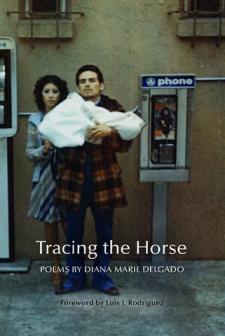 Set in Southern California’s San Gabriel Valley, Diana Marie Delgado’s debut poetry collection
Set in Southern California’s San Gabriel Valley, Diana Marie Delgado’s debut poetry collection
follows the coming-of-age of a young Mexican-American woman trying to make sense of who she is amidst a family and community weighted by violence and addiction.
With bracing vulnerability, the collection chronicles the effects of her father’s drug use and her brother’s incarceration, asking the reader to consider reclamation and the power of the self.
Diana Marie Delgado is the author of Tracing the Horse and the chapbook Late Night Talks with Men I Think I Trust. She is the recipient of numerous grants, including a fellowship from the National Endowment for the Arts. A graduate of Columbia University she currently resides in Tucson, where she is the Literary Director of the Poetry Center at the University of Arizona.
Come back with me
to the ruins.
We will look
through family
photographs;
I can show you
what the wind
and I did.
Who keeps
the stars
from falling
out of the sky?
Diana Marie Delgado
fragment from: Never Mind I’m Dead
Series: New Poets of America (Book 43)
Paperback: 112 pages
Publisher: BOA Editions Ltd.
September 10, 2019
Language: English
ISBN-10: 1942683871
ISBN-13: 978-1942683872
Product Dimensions: 6 x 0.2 x 8.5 inches
$ 17.00
# new poetry
Diana Marie Delgado
Tracing the Horse
• fleursdumal.nl magazine
More in: - Book News, Archive C-D, Archive C-D

Give me the splendid silent sun
1
Give me the splendid silent sun with all his beams full-dazzling,
Give me juicy autumnal fruit ripe and red from the orchard,
Give me a field where the unmow’d grass grows,
Give me an arbor, give me the trellis’d grape,
Give me fresh corn and wheat, give me serene-moving animals teaching content,
Give me nights perfectly quiet as on high plateaus west of the Mississippi, and I looking up at the stars,
Give me odorous at sunrise a garden of beautiful flowers where I can walk undisturb’d,
Give me for marriage a sweet-breath’d woman of whom I should never tire,
Give me a perfect child, give me away aside from the noise of the world a rural domestic life,
Give me to warble spontaneous songs recluse by myself, for my own ears only,
Give me solitude, give me Nature, give me again O Nature your primal sanities!
These demanding to have them, (tired with ceaseless excitement, and rack’d by the war-strife,)
These to procure incessantly asking, rising in cries from my heart,
While yet incessantly asking still I adhere to my city,
Day upon day and year upon year O city, walking your streets,
Where you hold me enchain’d a certain time refusing to give me up,
Yet giving to make me glutted, enrich’d of soul, you give me forever faces;
(O I see what I sought to escape, confronting, reversing my cries,
I see my own soul trampling down what it ask’d for.)
2
Keep your splendid silent sun,
Keep your woods O Nature, and the quiet places by the woods,
Keep your fields of clover and timothy, and your corn-fields and orchards,
Keep the blossoming buckwheat fields where the Ninth-month bees hum;
Give me faces and streets–give me these phantoms incessant and endless along the trottoirs!
Give me interminable eyes–give me women–give me comrades and lovers by the thousand!
Let me see new ones every day–let me hold new ones by the hand every day!
Give me such shows–give me the streets of Manhattan!
Give me Broadway, with the soldiers marching–give me the sound of the trumpets and drums!
(The soldiers in companies or regiments–some starting away, flush’d and reckless,
Some, their time up, returning with thinn’d ranks, young, yet very old, worn, marching, noticing nothing;)
Give me the shores and wharves heavy-fringed with black ships!
O such for me! O an intense life, full to repletion and varied!
The life of the theatre, bar-room, huge hotel, for me!
The saloon of the steamer! the crowded excursion for me! the torchlight procession!
The dense brigade bound for the war, with high piled military wagons following;
People, endless, streaming, with strong voices, passions, pageants,
Manhattan streets with their powerful throbs, with beating drums as now,
The endless and noisy chorus, the rustle and clank of muskets, (even the sight of the wounded,)
Manhattan crowds, with their turbulent musical chorus!
Manhattan faces and eyes forever for me.
Walt Whitman
(1819 – 1892)
Give me the splendid silent sun
From: Leaves of grass
• fleursdumal.nl magazine
More in: Archive W-X, Archive W-X, Whitman, Walt

Dusk
As flowers at dusk their choicest perfumes hold,
Some hearts hoard beauty when the body s old:
I see an age-bent woman lead the herd
To pasture, with no need of guiding word.
While the dull beasts in the tall grasses browse,
Inside her soul the earth s enchantments drowse ;
The needles pause between her wasted hands,
For light is always mellow where she stands.
No motion marks her life s harmonious dream ;
It is a part of Nature s quiet theme.
Each day renews the uneventful past,
Although her spirit nears a change at last.
From the grey threshold of her silent home
One night, her spirit, kin to evening s shade,
Will float away from crevices life made,
Like seaweed from a cliff into white foam.
Gladys Cromwell
(1885-1919)
Dusk
From: Songs of the Dust, 1915
• fleursdumal.nl magazine
More in: Archive C-D, Cromwell, Gladys, Gladys Cromwell
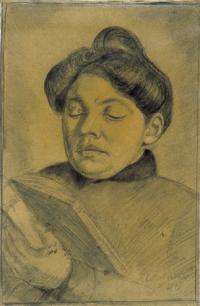
De pijl uit de aero.
Daar gaat
er een.
Pas op
span goed.
Straks zien
we weer
dat rood,
dat bloed.
Hoera!
Mik goed.
Het hart
doorboord.
Of neen
hem niet
direct
vermoord!
‘k Heb spijt
dat staal
niet brandt
niet pijnt.
Eén steek:
‘t Is uit:
De dood
verschijnt.
Alweer
een dood!
Geen kik,
geen kreet.
Dat is
niet schoon!
Geen pijn!
Geen leed!
Daal neer!
Ik doe
‘t niet meer:
‘t Is flauw!
Bloed, bloed!
‘k Verkies
het zwaard!
De houw!
Agnita Feis
(1881 – 1944)
Uit: Oorlog. Verzen in Staccato (1916).
De pijl uit de aero
Portret: Theo van Doesburg
• fleursdumal.nl magazine
More in: *War Poetry Archive, Agnita Feis, Antony Kok, Archive E-F, De Stijl, Doesburg, Theo van, Feis, Agnita, Kok, Antony, Theo van Doesburg, WAR & PEACE
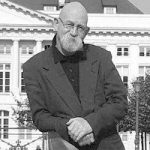
Het heuveltje van Gilliams
Uit het sprokkelhout van de herinnering nadert
hij na jaren het heuveltje waar het kreupelhout
dreigde weer, waar een mufriekende foefeling te
ritselen hangt. Hij was er bang. Waar is van sterre
der zee het licht, de weg? O reinste der schepselen.
Bert Bevers
Ongepubliceerd
Bert Bevers is a poet and writer who lives and works in Antwerp (Be)
• fleursdumal.nl magazine
More in: Archive A-B, Archive A-B, Bevers, Bert

City of ships
City of ships!
(O the black ships! O the fierce ships!
O the beautiful sharp-bow’d steam-ships and sail-ships!)
City of the world! (for all races are here,
All the lands of the earth make contributions here;)
City of the sea! city of hurried and glittering tides!
City whose gleeful tides continually rush or recede, whirling in and
out with eddies and foam!
City of wharves and stores–city of tall façades of marble and iron!
Proud and passionate city–mettlesome, mad, extravagant city!
Spring up, O city–not for peace alone, but be indeed yourself,
warlike!
Fear not–submit to no models but your own O city!
Behold me–incarnate me as I have incarnated you!
I have rejected nothing you offer’d me–whom you adopted I have
adopted,
Good or bad I never question you–I love all–I do not condemn any
thing,
I chant and celebrate all that is yours–yet peace no more,
In peace I chanted peace, but now the drum of war is mine,
War, red war is my song through your streets, O city!
Walt Whitman
(1819 – 1892)
City of ships
From: Leaves of grass
• fleursdumal.nl magazine
More in: Archive W-X, Archive W-X, Whitman, Walt

DITHYRAMBE
À M. Eugène de Genoude.
Son front est couronné de palmes et d’étoiles ;
Son regard immortel, que rien ne peut ternir,
Traversant tous les temps, soulevant tous les voiles,
Réveille le passé, plonge dans l’avenir !
Du monde sous ses yeux ses fastes se déroulent,
Les siècles à ses pieds comme un torrent s’écoulent ;
A son gré descendant ou remontant leurs cours,
Elle sonne aux tombeaux l’heure, l’heure fatale,
Ou sur sa lyre virginale
Chante au monde vieilli ce jour, père des jours !
— —
Ecoutez ! – Jéhova s’élance
Du sein de son éternité.
Le chaos endormi s’éveille en sa présence,
Sa vertu le féconde, et sa toute-puissance
Repose sur l’immensité !
Dieu dit, et le jour fut; Dieu dit, et les étoiles
De la nuit éternelle éclaircirent les voiles ;
Tous les éléments divers
A sa voix se séparèrent ;
Les eaux soudain s’écoulèrent
Dans le lit creusé des mers ;
Les montagnes s’élevèrent,
Et les aquilons volèrent
Dans les libres champs des airs !
Sept fois de Jéhova la parole féconde
Se fit entendre au monde,
Et sept fois le néant à sa voix répondit ;
Et Dieu dit : Faisons l’homme à ma vivante image.
Il dit, l’homme naquit; à ce dernier ouvrage
Le Verbe créateur s’arrête et s’applaudit !
— —
Mais ce n’est plus un Dieu ! – C’est l’homme qui soupire
Eden a fui !… voilà le travail et la mort !
Dans les larmes sa voix expire ;
La corde du bonheur se brise sur sa lyre,
Et Job en tire un son triste comme le sort.
— —
Ah ! périsse à jamais le jour qui m’a vu naître !
Ah ! périsse à jamais la nuit qui m’a conçu !
Et le sein qui m’a donné l’être,
Et les genoux qui m’ont reçu !
Que du nombre des jours Dieu pour jamais l’efface ;
Que, toujours obscurci des ombres du trépas,
Ce jour parmi les jours ne trouve plus sa place,
Qu’il soit comme s’il n’était pas !
Maintenant dans l’oubli je dormirais encore,
Et j’achèverais mon sommeil
Dans cette longue nuit qui n’aura point d’aurore,
Avec ces conquérants que la terre dévore,
Avec le fruit conçu qui meurt avant d’éclore
Et qui n’a pas vu le soleil.
Mes jours déclinent comme l’ombre ;
Je voudrais les précipiter.
O mon Dieu ! retranchez le nombre
Des soleils que je dois compter !
L’aspect de ma longue infortune
Eloigne, repousse, importune
Mes frères lassés de mes maux ;
En vain je m’adresse à leur foule,
Leur pitié m’échappe et s’écoule
Comme l’onde au flanc des coteaux.
Ainsi qu’un nuage qui passe,
Mon printemps s’est évanoui ;
Mes yeux ne verront plus la trace
De tous ces biens dont j’ai joui.
Par le souffle de la colère,
Hélas ! arraché à la terre,
Je vais d’où l’on ne revient pas !
Mes vallons, ma propre demeure,
Et cet oeil même qui me pleure,
Ne reverront jamais mes pas !
L’homme vit un jour sur la terre
Entre la mort et la douleur ;
Rassasié de sa misère,
Il tombe enfin comme la fleur ;
Il tombe ! Au moins par la rosée
Des fleurs la racine arrosée
Peut-elle un moment refleurir !
Mais l’homme, hélas!, après la vie,
C’est un lac dont l’eau s’est enfuie :
On le cherche, il vient de tarir.
Mes jours fondent comme la neige
Au souffle du courroux divin ;
Mon espérance, qu’il abrège,
S’enfuit comme l’eau de ma main ;
Ouvrez-moi mon dernier asile ;
Là, j’ai dans l’ombre un lit tranquille,
Lit préparé pour mes douleurs !
O tombeau ! vous êtes mon père !
Et je dis aux vers de la terre :
Vous êtes ma mère et mes sœurs !
Mais les jours heureux de l’impie
Ne s’éclipsent pas au matin ;
Tranquille, il prolonge sa vie
Avec le sang de l’orphelin !
Il étend au loin ses racines ;
Comme un troupeau sur les collines,
Sa famille couvre Ségor ;
Puis dans un riche mausolée
Il est couché dans la vallée,
Et l’on dirait qu’il vit encor.
C’est le secret de Dieu, je me tais et l’adore !
C’est sa main qui traça les sentiers de l’aurore,
Qui pesa l’Océan, qui suspendit les cieux !
Pour lui, l’abîme est nu, l’enfer même est sans voiles !
Il a fondé la terre et semé les étoiles !
Et qui suis-je à ses yeux ?
— —
Mais la harpe a frémi sous les doigts d’Isaïe ;
De son sein bouillonnant la menace à longs flots
S’échappe ; un Dieu l’appelle, il s’élance, il s’écrie :
Cieux et terre, écoutez ! silence au fils d’Amos !
— —
Osias n’était plus : Dieu m’apparut; je vis
Adonaï vêtu de gloire et d’épouvante !
Les bords éblouissants de sa robe flottante
Remplissaient le sacré parvis !
Des séraphins debout sur des marches d’ivoire
Se voilaient devant lui de six ailes de feux ;
Volant de l’un à l’autre, ils se disaient entre eux :
Saint, saint, saint, le Seigneur, le Dieu, le roi des dieux !
Toute la terre est pleine de sa gloire !
Du temple à ces accents la voûte s’ébranla,
Adonaï s’enfuit sous la nue enflammée :
Le saint lieu fut rempli de torrents de fumée.
La terre sous mes pieds trembla !
Et moi ! je resterais dans un lâche silence !
Moi qui t’ai vu, Seigneur, je n’oserais parler !
A ce peuple impur qui t’offense
Je craindrais de te révéler !
Qui marchera pour nous ? dit le Dieu des armées.
Qui parlera pour moi ? dit Dieu : Qui ? moi, Seigneur !
Touche mes lèvres enflammées !
Me voilà ! je suis prêt !… malheur !
Malheur à vous qui dès l’aurore
Respirez les parfums du vin !
Et que le soir retrouve encore
Chancelants aux bords du festin !
Malheur à vous qui par l’usure
Etendez sans fin ni mesure
La borne immense de vos champs !
Voulez-vous donc, mortels avides,
Habiter dans vos champs arides,
Seuls, sur la terre des vivants ?
Malheur à vous, race insensée !
Enfants d’un siècle audacieux,
Qui dites dans votre pensée :
Nous sommes sages à nos yeux :
Vous changez ma nuit en lumière,
Et le jour en ombre grossière
Où se cachent vos voluptés !
Mais, comme un taureau dans la plaine,
Vous traînez après vous la chaîne
Des vos longues iniquités !
Malheur à vous, filles de l’onde !
Iles de Sydon et de Tyr !
Tyrans ! qui trafiquez du monde
Avec la pourpre et l’or d’Ophyr !
Malheur à vous ! votre heure sonne !
En vain l’Océan vous couronne,
Malheur à toi, reine des eaux,
A toi qui, sur des mers nouvelles,
Fais retentir comme des ailes
Les voiles de mille vaisseaux !
Ils sont enfin venus les jours de ma justice ;
Ma colère, dit Dieu, se déborde sur vous !
Plus d’encens, plus de sacrifice
Qui puisse éteindre mon courroux !
Je livrerai ce peuple à la mort, au carnage ;
Le fer moissonnera comme l’herbe sauvage
Ses bataillons entiers !
– Seigneur ! épargnez-nous ! Seigneur ! – Non, point de trêve,
Et je ferai sur lui ruisseler de mon glaive
Le sang de ses guerriers !
Ses torrents sécheront sous ma brûlante haleine ;
Ma main nivellera, comme une vaste plaine,
Ses murs et ses palais ;
Le feu les brûlera comme il brûle le chaume.
Là, plus de nation, de ville, de royaume ;
Le silence à jamais !
Ses murs se couvriront de ronces et d’épines ;
L’hyène et le serpent peupleront ses ruines ;
Les hiboux, les vautours,
L’un l’autre s’appelant durant la nuit obscure,
Viendront à leurs petits porter la nourriture
Au sommet de ses tours !
— —
Mais Dieu ferme à ces mots les lèvres d’Isaïe ;
Le sombre Ezéchiel
Sur le tronc desséché de l’ingrat Israël
Fait descendre à son tour la parole de vie.
— —
L’Eternel emporta mon esprit au désert :
D’ossements desséchés le sol était couvert ;
J’approche en frissonnant; mais Jéhova me crie :
Si je parle à ces os, reprendront-ils la vie ?
– Eternel, tu le sais ! – Eh bien! dit le Seigneur,
Ecoute mes accents ! retiens-les et dis-leur :
Ossements desséchés ! insensible poussière !
Levez-vous ! recevez l’esprit et la lumière !
Que vos membres épars s’assemblent à ma voix !
Que l’esprit vous anime une seconde fois !
Qu’entre vos os flétris vos muscles se replacent !
Que votre sang circule et vos nerfs s’entrelacent !
Levez-vous et vivez, et voyez qui je suis !
J’écoutai le Seigneur, j’obéis et je dis :
Esprits, soufflez sur eux du couchant, de l’aurore ;
Soufflez de l’aquilon, soufflez !… Pressés d’éclore,
Ces restes du tombeau, réveillés par mes cris,
Entrechoquent soudain leurs ossements flétris ;
Aux clartés du soleil leur paupière se rouvre,
Leurs os sont rassemblés, et la chair les recouvre !
Et ce champ de la mort tout entier se leva,
Redevint un grand peuple, et connut Jéhova !
— —
Mais Dieu de ses enfants a perdu la mémoire ;
La fille de Sion, méditant ses malheurs,
S’assied en soupirant, et, veuve de sa gloire,
Ecoute Jérémie, et retrouve des pleurs.
— —
Le seigneur, m’accablant du poids de sa colère,
Retire tour à tour et ramène sa main ;
Vous qui passez par le chemin,
Est-il une misère égale à ma misère ?
En vain ma voix s’élève, il n’entend plus ma voix ;
Il m’a choisi pour but de ses flèches de flamme,
Et tout le jour contre mon âme
Sa fureur a lancé les fils de son carquois !
Sur mes os consumés ma peau s’est desséchée ;
Les enfants m’ont chanté dans leurs dérisions ;
Seul, au milieu des nations,
Le Seigneur m’a jeté comme une herbe arrachée.
Il s’est enveloppé de son divin courroux ;
Il a fermé ma route, il a troublé ma voie ;
Mon sein n’a plus connu la joie,
Et j’ai dit au Seigneur : Seigneur, souvenez-vous,
Souvenez-vous, Seigneur, de ces jours de colère ;
Souvenez-vous du fiel dont vous m’avez nourri ;
Non, votre amour n’est point tari :
Vous me frappez, Seigneur, et c’est pourquoi j’espère.
Je repasse en pleurant ces misérables jours ;
J’ai connu le Seigneur dès ma plus tendre aurore :
Quand il punit, il aime encore ;
Il ne s’est pas, mon âme, éloigné pour toujours.
Heureux qui le connaît ! heureux qui dès l’enfance
Porta le joug d’un Dieu, clément dans sa rigueur !
Il croit au salut du Seigneur,
S’assied au bord du fleuve et l’attend en silence.
Il sent peser sur lui ce joug de votre amour ;
Il répand dans la nuit ses pleurs et sa prière,
Et la bouche dans la poussière,
Il invoque, il espère, il attend votre jour.
— —
Silence, ô lyre ! et vous silence,
Prophètes, voix de l’avenir !
Tout l’univers se tait d’avance
Devant celui qui doit venir !
Fermez-vous, lèvres inspirées ;
Reposez-vous, harpes sacrées,
Jusqu’au jour où sur les hauts lieux
Une voix au monde inconnue,
Fera retentir dans la nue :
PAIX A LA TERRE, ET GLOIRE AUX CIEUX !
Alphonse de Lamartine
(1790 – 1869)
La poésie sacrée par Alphonse De Lamartine
DITHYRAMBE
Méditations poétiques
• fleursdumal.nl magazine
More in: Archive K-L, Archive K-L, CLASSIC POETRY
Jonas Wijtenburg (Utrecht 1989) gebruikte van 18 januari tot en met 7 februari PARK als productieplek voor nieuw werk.
 Van 8 februari tot en met 1 maart toont hij in de solotentoonstelling Setting/Unsetting/Resetting de resultaten hiervan in een modulair paviljoen waarin tevens werken te zien zijn die hij eerder realiseerde in de kunstenaarswerkplaatsen Beeldenstorm in Eindhoven en het EKWC in Oisterwijk.
Van 8 februari tot en met 1 maart toont hij in de solotentoonstelling Setting/Unsetting/Resetting de resultaten hiervan in een modulair paviljoen waarin tevens werken te zien zijn die hij eerder realiseerde in de kunstenaarswerkplaatsen Beeldenstorm in Eindhoven en het EKWC in Oisterwijk.
Zijn ambachtelijke vertalingen van een industrieel idioom in hout, staal, keramiek en brons komen bij PARK samen in een Gesamtkunstwerk. Paviljoen en sculpturen laten zich lezen vanuit een herkenbare en directe beeldtaal.
U bent van harte uitgenodigd voor de opening op zaterdag 8 februari om 16.00 uur die verricht zal worden door Ranti Tjan, directeur Sundaymorning@EKWC.
SETTING/UNSETTING/RESETTING
tentoonstelling Jonas Wijtenburg
18.01 – 01.03 2020
Opening 8 februari 16.00 uur
PARK Wilhelminapark 53, 5041 ED Tilburg – Tijdens de tentoonstelling geopend: vrijdag van 13.00 tot 17.00 uur zaterdag van 13.00 tot 17.00 uur zondag van 13.00 tot 17.00 uur toegang is gratis
PARK is een kunstinitiatief opgericht in 2013 door Rob Moonen in samenwerking met een zestal andere Tilburgse kunstenaars. Op dit moment bestaat de PARK werkgroep uit Linda Arts, René Korten, Rob Moonen en Liza Voetman.
PARK ziet de noodzaak van een middenpodium dat zich positioneert tussen Kunstpodium T en Museum De Pont en zet zich daarvoor in door een tentoonstellingsprogramma in de voormalige Goretti-kapel aan het Wilhelminapark te Tilburg te realiseren.
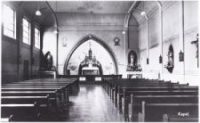 PARK ligt op 10 minuten loopafstand van het Centraal Station Tilburg in de nabijheid van Museum De Pont. Er is beperkt parkeergelegenheid voor de deur.
PARK ligt op 10 minuten loopafstand van het Centraal Station Tilburg in de nabijheid van Museum De Pont. Er is beperkt parkeergelegenheid voor de deur.
# Meer informatie op website PARK
• fleursdumal.nl magazine
More in: Art & Literature News, Exhibition Archive, FDM Art Gallery, Linda Arts, Park, The talk of the town
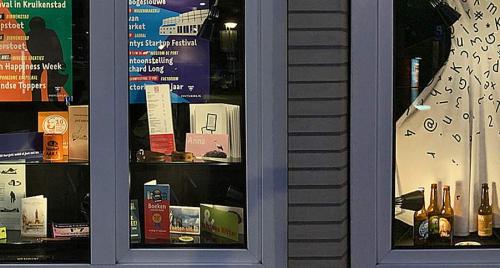
METROPOLITAN MUSEUM | TILBURG: Overzichtstentoonstelling vier jaar TilburgsAns, een kunstproject van Sander Neijnens en Ivo van Leeuwen
Wè knòrrie?
Sinds april 2016 zwerft TilburgsAns door de stad, een lettertype met eigenzinnige karakters en inmiddels 123 pictogrammen. Het lettertype is ontworpen door Sander Neijnens en geïnspireerd op het rauwe, eigenzinnige, humoristische, verrassende en experimentele karakter van Tilburg. De pictogrammen van karakteristieke Tilburgse locaties, evenementen, verhalen en woorden zijn van de hand van Ivo van Leeuwen. TilburgsAns is een uniek (typo)grafisch portret van Tilburg. Dit kunstproject is omarmd door de inwoners van de stad.

Het lettertype wordt op allerlei manieren toegepast in wijkkranten, kleding, etiketten, plattegronden, kaarten, stickers, posters, flyers en tatoeages. Daarnaast organiseerden de ontwerpers de wekelijkse kaajbaandexpositie van pictogrammen op de vuilcontainers van 81 huishoudens en hielden zij reeds vele workshops, lezingen in binnen- en buitenland en lessen voor basis-, middelbaar en hoger onderwijs. Ook presenteerden zij ‘Dègge bedankt zèèt dè witte wèèn’ en ‘We zullen et saome wel rôoje wèèn’, Chocolinde sjeklaatjes, de Tilburgse lekkernij met een Q en een serie speldjes. Na vier jaar wordt de tussenbalans opgemaakt met deze expositie in het Metropolitan Museum Tilburg, de raamtentoonstellingen aan de Stedekestraat 15 te Tilburg.
Het lettertype TilburgsAns kan gratis gedownload worden op de website www.tilburgsans.nl. Daar treft u ook nadere achtergrondinformatie over het project en het bijbehorende letteradoptieplan alsmede vele voorbeelden van hoe het lettertype en de pictogrammen in en buiten de stad worden toegepast.
Gratis raamtentoonstelling
‘Wè knòrrie?’ van TilburgsAns
Sander Neijnens en Ivo van Leeuwen
dagelijks nog t/m 18 februari 2020
‘Metropolitan Museum | Tilburg’
Stedekestraat 15 | 5041DM Tilburg
Sjon Brands en Dorith van der Lee
telefoon 013 5358041 | 06 20325030
mail post@metropolitanmuseum.nl
site www.metropolitanmuseum.nl
• fleursdumal.nl magazine
More in: - Book Lovers, Archive K-L, Archive M-N, Art & Literature News, Exhibition Archive, Ivo van Leeuwen, Metropolitan Museum Tilburg, Sander Neijnens, Theater van de Verloren Tijd
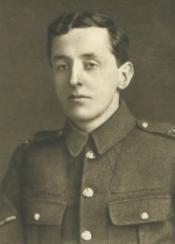
A Soldiers’ Cemetery
Behind that long and lonely trenchèd line
To which men come and go, where brave men die,
There is a yet unmarked and unknown shrine,
A broken plot, a soldiers’ cemet’ry.
There lie the flower of Youth, the men who scorned
To live (so died) when languished liberty:
Across their graves, flowerless and unadorned,
Still scream the shells of each artillery.
When war shall cease this lonely, unknown spot
Of many a pilgrimage will be the end,
And flowers will bloom in this now barren plot
And fame upon it through the years descend –
But many a heart upon each simple cross
Will hang the grief, the memory of its loss.
John William (Will) Streets
(1886 –1916)
A Soldiers’ Cemetery
• fleursdumal.nl magazine
More in: - Archive Tombeau de la jeunesse, Archive S-T, Streets, Will, WAR & PEACE

POËZIEWEEK IN NEDERLAND EN VLAANDEREN 2020
nog t/m 5 februari 2020
# meer informatie op website poëzieweek:
https://www.poezieweek.com/
More in: #More Poetry Archives, - Bookstores, AUDIO, CINEMA, RADIO & TV, City Poets / Stadsdichters, CLASSIC POETRY, CONCRETE , VISUAL & SOUND POETRY, EXPERIMENTAL POETRY, LIGHT VERSE, MODERN POETRY, Poëzieweek, STREET POETRY, TRAVESTY & POETRY
Thank you for reading Fleurs du Mal - magazine for art & literature